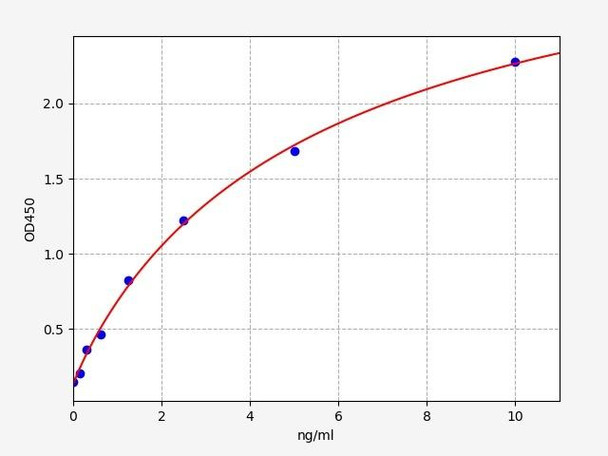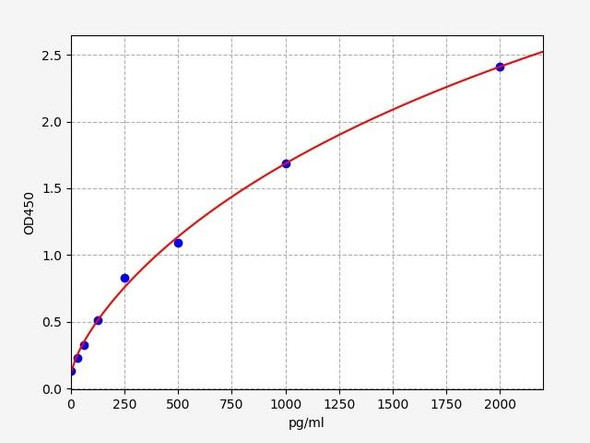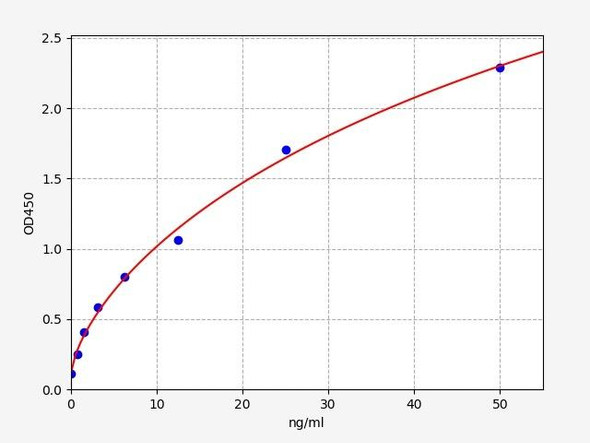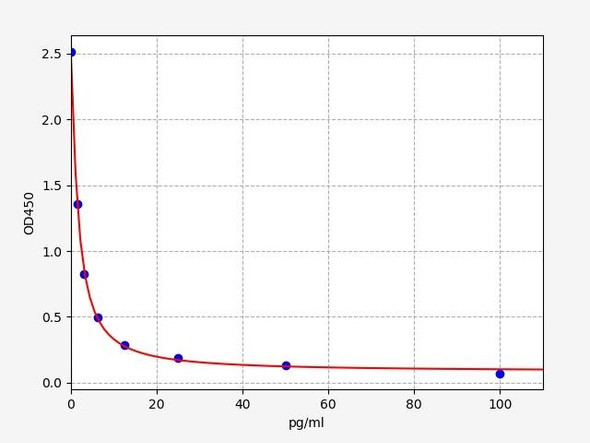Human XBP1 ELISA Kit
- SKU:
- HUFI02090
- Product Type:
- ELISA Kit
- Size:
- 96 Assays
- Uniprot:
- P17861
- Sensitivity:
- 0.094ng/ml
- Range:
- 0.156-10ng/ml
- ELISA Type:
- Sandwich ELISA, Double Antibody
- Synonyms:
- XBP1, HTF, TREB5, XBP2, TREB5, X-box binding protein 1, X-box-binding protein 1, XBP-1, XBP2Tax-responsive element-binding protein 5
- Reactivity:
- Human
Description
| Product Name: | Human XBP1 ELISA Kit |
| Product Code: | HUFI02090 |
| Size: | 96 Assays |
| Alias: | XBP1, HTF, TREB5, XBP2, TREB5, X-box binding protein 1, X-box-binding protein 1, XBP-1, XBP2Tax-responsive element-binding protein 5 |
| Detection method: | Sandwich ELISA, Double Antibody |
| Application: | This immunoassay kit allows for the in vitro quantitative determination of Human XBP1 concentrations in serum plasma and other biological fluids. |
| Sensitivity: | 0.094ng/ml |
| Range: | 0.156-10ng/ml |
| Storage: | 4°C for 6 months |
| Note: | For Research Use Only |
| Recovery: | Matrices listed below were spiked with certain level of Human XBP1 and the recovery rates were calculated by comparing the measured value to the expected amount of Human XBP1 in samples. | ||||||||||||||||
| |||||||||||||||||
| Linearity: | The linearity of the kit was assayed by testing samples spiked with appropriate concentration of Human XBP1 and their serial dilutions. The results were demonstrated by the percentage of calculated concentration to the expected. | ||||||||||||||||
| |||||||||||||||||
| CV(%): | Intra-Assay: CV<8% Inter-Assay: CV<10% |
| Component | Quantity | Storage |
| ELISA Microplate (Dismountable) | 8×12 strips | 4°C for 6 months |
| Lyophilized Standard | 2 | 4°C/-20°C |
| Sample/Standard Dilution Buffer | 20ml | 4°C |
| Biotin-labeled Antibody(Concentrated) | 120ul | 4°C (Protect from light) |
| Antibody Dilution Buffer | 10ml | 4°C |
| HRP-Streptavidin Conjugate(SABC) | 120ul | 4°C (Protect from light) |
| SABC Dilution Buffer | 10ml | 4°C |
| TMB Substrate | 10ml | 4°C (Protect from light) |
| Stop Solution | 10ml | 4°C |
| Wash Buffer(25X) | 30ml | 4°C |
| Plate Sealer | 5 | - |
Other materials and equipment required:
- Microplate reader with 450 nm wavelength filter
- Multichannel Pipette, Pipette, microcentrifuge tubes and disposable pipette tips
- Incubator
- Deionized or distilled water
- Absorbent paper
- Buffer resevoir
| Uniprot | P17861 |
| UniProt Protein Function: | XBP1: a transcription factor essential for hepatocyte growth, the differentiation of plasma cells, immunoglobulin secretion, and the unfolded protein response (UPR). XBP1 mRNA is spliced by IRE1 during the UPR to generate a new C-terminus, converting it into a potent unfolded-protein response transcriptional activator and triggering growth arrest and apoptosis. Only the spliced form of XBP1 can activate the UPR efficiently. Activates UPR target genes via direct binding to the UPR element (UPRE). Binds DNA preferably to the CRE-like element 5'-GATGACGTG[TG]N(3)[AT]T-3', and also to some TPA response elements (TRE). Binds to the HLA DR-alpha promoter. Binds to the Tax-responsive element (TRE) of HTLV-I. Up-regulated by ATF6 via direct binding to the ERSE in response to endoplasmic reticulum stress. Genetic variations in XBP1 could be associated with susceptibility to major affective disorder type 7 (MAFD7). Major affective disorders represent a class of mental disorders characterized by a disturbance in mood as their predominant feature. Two human isoforms are produced by alternative splicing. Isoform 1 is also known as XBP-1U. Isoform 2, also known as XBP-1S, is produced by IRE1 in response to endoplasmic reticulum stress. IRE1 cleaves a 26-bp fragment causing a frameshift of the mRNA transcript. |
| UniProt Protein Details: | Protein type:DNA-binding; Transcription factor Chromosomal Location of Human Ortholog: 22q12.1|22q12 Cellular Component: nucleoplasm; endoplasmic reticulum membrane; endoplasmic reticulum; cytoplasm; integral to membrane; integral to endoplasmic reticulum membrane; nucleus; cytosol Molecular Function:protein binding; protein homodimerization activity; protease binding; DNA binding; protein heterodimerization activity; chromatin DNA binding; ubiquitin protein ligase binding; estrogen receptor binding; transcription factor activity; protein kinase binding Biological Process: ubiquitin-dependent protein catabolic process; transcription from RNA polymerase II promoter; phosphoinositide 3-kinase cascade; muscle development; apoptosis; exocrine pancreas development; positive regulation of transcription of target genes involved in unfolded protein response; regulation of protein stability; negative regulation of transcription from RNA polymerase II promoter; cellular response to glucose starvation; protein transport; serotonin secretion, neurotransmission; positive regulation of MHC class II biosynthetic process; positive regulation of transcription factor import into nucleus; angiogenesis; response to electrical stimulus; cell growth; positive regulation of autophagy; fatty acid biosynthetic process; positive regulation of TOR signaling pathway; response to drug; positive regulation of histone methylation; protein destabilization; unfolded protein response; organelle organization and biogenesis; cellular response to nutrient; positive regulation of immunoglobulin secretion; liver development; positive regulation of immunoglobulin production; cholesterol homeostasis; unfolded protein response, activation of signaling protein activity; cellular protein metabolic process; cellular response to insulin stimulus; positive regulation of T cell differentiation; fatty acid homeostasis; endothelial cell proliferation; positive regulation of B cell differentiation; positive regulation of fat cell differentiation; neuron development; autophagy; immune response; positive regulation of transcription from RNA polymerase II promoter; positive regulation of protein amino acid phosphorylation; sterol homeostasis; vascular endothelial growth factor receptor signaling pathway; negative regulation of apoptosis Disease: Major Affective Disorder 7 |
| NCBI Summary: | This gene encodes a transcription factor that regulates MHC class II genes by binding to a promoter element referred to as an X box. This gene product is a bZIP protein, which was also identified as a cellular transcription factor that binds to an enhancer in the promoter of the T cell leukemia virus type 1 promoter. It may increase expression of viral proteins by acting as the DNA binding partner of a viral transactivator. It has been found that upon accumulation of unfolded proteins in the endoplasmic reticulum (ER), the mRNA of this gene is processed to an active form by an unconventional splicing mechanism that is mediated by the endonuclease inositol-requiring enzyme 1 (IRE1). The resulting loss of 26 nt from the spliced mRNA causes a frame-shift and an isoform XBP1(S), which is the functionally active transcription factor. The isoform encoded by the unspliced mRNA, XBP1(U), is constitutively expressed, and thought to function as a negative feedback regulator of XBP1(S), which shuts off transcription of target genes during the recovery phase of ER stress. A pseudogene of XBP1 has been identified and localized to chromosome 5. [provided by RefSeq, Jul 2008] |
| UniProt Code: | P17861 |
| NCBI GenInfo Identifier: | 60416406 |
| NCBI Gene ID: | 7494 |
| NCBI Accession: | P17861.2 |
| UniProt Secondary Accession: | P17861,Q8WYK6, Q969P1, Q96BD7, |
| UniProt Related Accession: | P17861 |
| Molecular Weight: | 40,148 Da |
| NCBI Full Name: | X-box-binding protein 1 |
| NCBI Synonym Full Names: | X-box binding protein 1 |
| NCBI Official Symbol: | XBP1 |
| NCBI Official Synonym Symbols: | XBP2; TREB5; XBP-1 |
| NCBI Protein Information: | X-box-binding protein 1; tax-responsive element-binding protein 5 |
| UniProt Protein Name: | X-box-binding protein 1 |
| UniProt Synonym Protein Names: | Tax-responsive element-binding protein 5 |
| Protein Family: | X-box-binding protein |
| UniProt Gene Name: | XBP1 |
| UniProt Entry Name: | XBP1_HUMAN |
*Note: Protocols are specific to each batch/lot. For the correct instructions please follow the protocol included in your kit.
Before adding to wells, equilibrate the SABC working solution and TMB substrate for at least 30 min at 37°C. When diluting samples and reagents, they must be mixed completely and evenly. It is recommended to plot a standard curve for each test.
| Step | Protocol |
| 1. | Set standard, test sample and control (zero) wells on the pre-coated plate respectively, and then, record their positions. It is recommended to measure each standard and sample in duplicate. Wash plate 2 times before adding standard, sample and control (zero) wells! |
| 2. | Aliquot 0.1ml standard solutions into the standard wells. |
| 3. | Add 0.1 ml of Sample / Standard dilution buffer into the control (zero) well. |
| 4. | Add 0.1 ml of properly diluted sample ( Human serum, plasma, tissue homogenates and other biological fluids.) into test sample wells. |
| 5. | Seal the plate with a cover and incubate at 37 °C for 90 min. |
| 6. | Remove the cover and discard the plate content, clap the plate on the absorbent filter papers or other absorbent material. Do NOT let the wells completely dry at any time. Wash plate X2. |
| 7. | Add 0.1 ml of Biotin- detection antibody working solution into the above wells (standard, test sample & zero wells). Add the solution at the bottom of each well without touching the side wall. |
| 8. | Seal the plate with a cover and incubate at 37°C for 60 min. |
| 9. | Remove the cover, and wash plate 3 times with Wash buffer. Let wash buffer rest in wells for 1 min between each wash. |
| 10. | Add 0.1 ml of SABC working solution into each well, cover the plate and incubate at 37°C for 30 min. |
| 11. | Remove the cover and wash plate 5 times with Wash buffer, and each time let the wash buffer stay in the wells for 1-2 min. |
| 12. | Add 90 µl of TMB substrate into each well, cover the plate and incubate at 37°C in dark within 10-20 min. (Note: This incubation time is for reference use only, the optimal time should be determined by end user.) And the shades of blue can be seen in the first 3-4 wells (with most concentrated standard solutions), the other wells show no obvious color. |
| 13. | Add 50 µl of Stop solution into each well and mix thoroughly. The color changes into yellow immediately. |
| 14. | Read the O.D. absorbance at 450 nm in a microplate reader immediately after adding the stop solution. |
When carrying out an ELISA assay it is important to prepare your samples in order to achieve the best possible results. Below we have a list of procedures for the preparation of samples for different sample types.
| Sample Type | Protocol |
| Serum | If using serum separator tubes, allow samples to clot for 30 minutes at room temperature. Centrifuge for 10 minutes at 1,000x g. Collect the serum fraction and assay promptly or aliquot and store the samples at -80°C. Avoid multiple freeze-thaw cycles. If serum separator tubes are not being used, allow samples to clot overnight at 2-8°C. Centrifuge for 10 minutes at 1,000x g. Remove serum and assay promptly or aliquot and store the samples at -80°C. Avoid multiple freeze-thaw cycles. |
| Plasma | Collect plasma using EDTA or heparin as an anticoagulant. Centrifuge samples at 4°C for 15 mins at 1000 × g within 30 mins of collection. Collect the plasma fraction and assay promptly or aliquot and store the samples at -80°C. Avoid multiple freeze-thaw cycles. Note: Over haemolysed samples are not suitable for use with this kit. |
| Urine & Cerebrospinal Fluid | Collect the urine (mid-stream) in a sterile container, centrifuge for 20 mins at 2000-3000 rpm. Remove supernatant and assay immediately. If any precipitation is detected, repeat the centrifugation step. A similar protocol can be used for cerebrospinal fluid. |
| Cell culture supernatant | Collect the cell culture media by pipette, followed by centrifugation at 4°C for 20 mins at 1500 rpm. Collect the clear supernatant and assay immediately. |
| Cell lysates | Solubilize cells in lysis buffer and allow to sit on ice for 30 minutes. Centrifuge tubes at 14,000 x g for 5 minutes to remove insoluble material. Aliquot the supernatant into a new tube and discard the remaining whole cell extract. Quantify total protein concentration using a total protein assay. Assay immediately or aliquot and store at ≤ -20 °C. |
| Tissue homogenates | The preparation of tissue homogenates will vary depending upon tissue type. Rinse tissue with 1X PBS to remove excess blood & homogenize in 20ml of 1X PBS (including protease inhibitors) and store overnight at ≤ -20°C. Two freeze-thaw cycles are required to break the cell membranes. To further disrupt the cell membranes you can sonicate the samples. Centrifuge homogenates for 5 mins at 5000xg. Remove the supernatant and assay immediately or aliquot and store at -20°C or -80°C. |
| Tissue lysates | Rinse tissue with PBS, cut into 1-2 mm pieces, and homogenize with a tissue homogenizer in PBS. Add an equal volume of RIPA buffer containing protease inhibitors and lyse tissues at room temperature for 30 minutes with gentle agitation. Centrifuge to remove debris. Quantify total protein concentration using a total protein assay. Assay immediately or aliquot and store at ≤ -20 °C. |
| Breast Milk | Collect milk samples and centrifuge at 10,000 x g for 60 min at 4°C. Aliquot the supernatant and assay. For long term use, store samples at -80°C. Minimize freeze/thaw cycles. |










